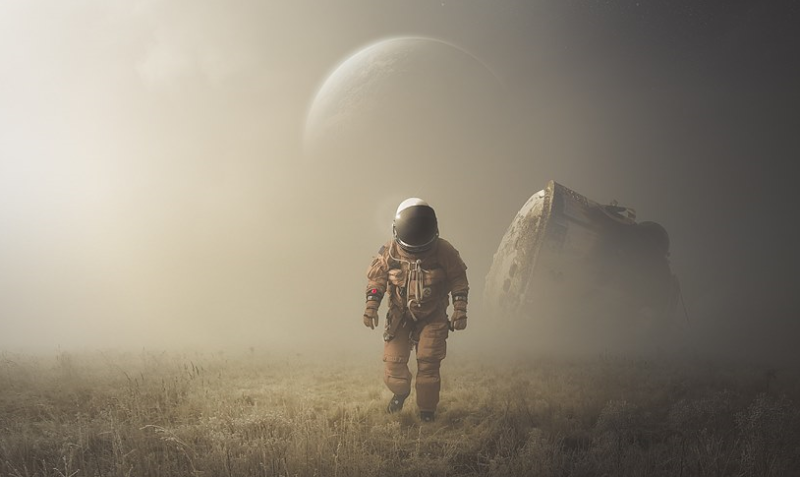
Earlier this month, the White House’s Office of Science and Technology assembled a strange gathering: scientists, artists, engineers, and policy-makers, for a workshop designed to imagine how humanity could settle the solar system.
The workshop, held in early February, was titled Homesteading in Space – Inspiring the Nation through Science Fiction, with the express purpose of imagining how manned space efforts can take us to our neighboring planets, not just for a short visit, but for longer durations.
Tom Kalil, is the Deputy Director for Policy for the White House Office of Science and Technology Policy, who’s office co-sponsored the gathering along with Washington DC’s Museum of Science Fiction. He noted in an interview that in 2013, he came across a paper “by a team of a NASA scientists entitled ‘Affordable, Rapid Bootstrapping of the Space Industry and Solar System Civilization,’ which inspired a White House blog post I published in 2014 on this topic.”
Advertisement

In that post, he spoke with Dr. Phillip Metzger, a former research physicist at NASA’s Kennedy Space Center about the challenges of getting to space: essentially, bringing resources into orbit. If these resources can be obtained from outside of Earth’s orbit, the cost to maintain a presence in space drops.
If we want to want to create a robust civilization in our solar system, more of the energy, raw materials, and equipment that we use in space has to come from space. Launching everything we need from Earth is too expensive. It would also be too expensive to send all of the factories required to manufacture everything necessary to support a solar system civilization.
Ultimately what we need to do is to evolve a complete supply chain in space, utilizing the energy and resources of space along the way. We are calling this approach “bootstrapping” because of the old saying that you have to pull yourself up by your own bootstraps. Industry in space can start small then pull itself up to more advanced levels through its own productivity, minimizing the cost of launching things from Earth in the meantime. Obviously, this isn’t going to happen overnight, but I think that it is the right long-term goal.
In his 2015 State of the Union, President Obama noted that we want to go to space, “not just to visit, but to stay.”
Sponsored
To further that goal, Kalil and the Museum of Science Fiction realized that there’s considerable work to be done in order to make it a reality. Experts in science and engineering are important, but he understood that there “would be a value in bringing together artists and scientists to explore this challenge.”
Science fiction isn’t a proscriptive genre for the future, but what it can do is inspire. “As a society, we have to decide whether this is a challenge we want to embrace,” Kalil noted. “Not everyone will be persuaded by George Mallory’s rationale for wanting to climb Mt. Everest (“Because it’s there). Artists can explore different ideas about why we should do this.”

Kalil noted that while science fiction can’t provide concrete answers to the problems and challenges at hand, it can be useful:
Advertisement
“I believe that science fiction can provide a simulator for the societal risks and benefits of new technologies. This is useful in the same way that scenario planning helps organizations prepare for the future.”
This fits with a growing trend within the science fiction community itself – recently released books such as The Martian by Andy Weir, Seveneves by Neil Stephenson and Aurora by Kim Stanley Robinson are each deeply focused on optimistic futures, rather than dystopian ones. “I believe those kinds of stories can serve as positive self-fulfilling prophesies, and provide a useful counterbalance to dystopian science fiction.”
The event itself was broken into several broad categories for subject matter experts to consider:
- Exploring Space: How will we leave the earth and travel to other planets?
- Prospecting: How will we find and collect chemicals and minerals from asteroids and other planets?
- Manufacturing: How will we make the materials and manufacture the things we need to build a community on another planet?
- Bioengineering: How will we use biotechnology, including synthetic biology, to create food, fuel, and useful chemicals using engineered bacteria and plant life?
- World Building: How will we not only survive but thrive in space, creating communities and maintaining our physical and mental health?
“In the near term, we need to be able to locate, extract, process and use materials like water, oxygen, rocket fuel, and metals,” Kalil explained. “Over the longer term, scientists and engineers have even more transformative ideas that take advantage of current and future capabilities in synthetic biology, robotics, digital materials, exponential manufacturing, and an interplanetary Internet.”
Coming up next, Kalil noted that he’s interested in seeing what artists and scientists can come up with together: as scientists and engineers come up with concepts, they’ll provide useful building blocks for authors, which in turn help to inspire others down a scientifically-inclined path. Science Fiction can help lead the way and contribute to that future.
Contact the author at andrew.liptak@io9.com.













